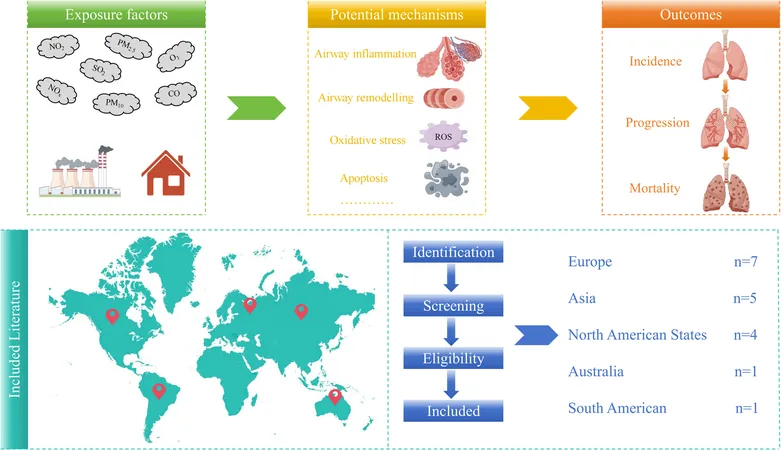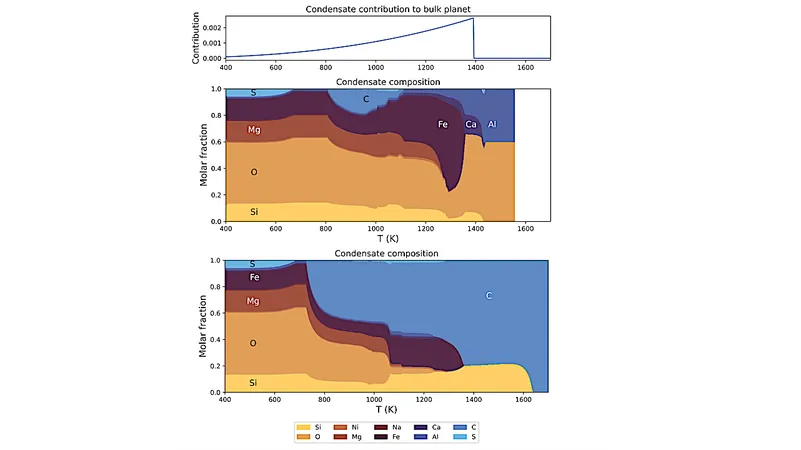
Breath of Danger: How Air Pollution Fuels Idiopathic Pulmonary Fibrosis Progression
2025-08-22
Author: Daniel
Unveiling the Hidden Dangers of Air Pollution on Lung Health
In a groundbreaking systematic review and meta-analysis, researchers have revealed alarming connections between air pollutants and idiopathic pulmonary fibrosis (IPF)—a progressive lung disease that often leads to fatal outcomes. This comprehensive study, adhering to the stringent PRISMA guidelines, aims to shed light on how poor air quality impacts the incidence, progression, and mortality rates associated with IPF.
The Quest for Data: How Researchers Conducted Their Study
To gather the necessary data, the research team scoured major electronic databases such as Embase, Web of Science, and PubMed, focusing primarily on English-language literature. Their search targeted key air pollutants like PM2.5, PM10, NO2, and SO2, alongside IPF outcomes such as incidence and progression, using a well-defined methodology validated by the National Library of Medicine.
Rigorous Selection Criteria: Ensuring Quality and Relevance
Using the PECO-S framework, the team established strict inclusion criteria for studies, ensuring only observational studies in the general population were considered. Special populations or studies lacking relevant data were excluded, allowing only the most pertinent research to contribute to their findings.
Extracting Meaningful Data: The Steps Taken
The evaluators meticulously extracted significant data points from the eligible studies, focusing on study design, air pollution exposure levels, IPF outcomes, and relevant covariates such as age and smoking status. This detailed information provided a rich dataset for subsequent analysis.
Key Findings: Pollutants Linked to IPF Progression and Mortality
The analysis uncovered a worrying association between pollutants like CO, NO2, and PM2.5 with IPF disease progression, underscoring how these invisible toxins can worsen lung function and accelerate disease progression. For instance, a mere increase of 10 µg/m3 in NO2 was linked to a 32% increased risk of progression.
Incidence Under Fire: Pollutants and IPF Onset
Findings also highlight that exposure to NO2 and PM10 significantly increased the likelihood of developing IPF, with clear links established across multiple studies. However, not all pollutants bore the same weight; pollutants like CO and O3 didn’t show significant associations with new cases of IPF.
Why No Love Lost: Air Pollution's Impact on IPF Mortality
Interestingly, the study found no significant correlation between these pollutants and mortality rates from IPF, raising questions about advanced disease stages where patients may not be as reactive to environmental factors.
Analyzing the Variability: What Influences the Impact of Air Pollution?
Further subgroup analyses illuminated how factors like age, sex, and geographic location influenced these risks. Particularly, it seemed that men were at greater risk of disease progression due to higher smoking rates, exacerbating the effects of air pollution.
A Call for Action: Addressing Knowledge Gaps
Despite these insights, gaps remain in understanding the causal relationships between these pollutants and IPF. There's an urgent need for future studies to explore how socioeconomic factors, occupational exposures, and comorbidities could impact these associations.
Looking Forward: The Importance of Standardization in Future Research
As the conversation around air quality and health continues, this study emphasizes the importance of standardizing definitions and methodologies in IPF research to improve the quality and applicability of future findings. If we are to mitigate the damage done by air pollution, both public health initiatives and further academic inquiry are essential.
The Bottom Line: Your Lungs are at Risk!
This monumental study offers a clarion call to acknowledge the consequences of air pollution on lung health, particularly relating to conditions like IPF. As urbanization and pollution levels rise, understanding these connections could be pivotal in crafting effective health policies and raising awareness about the dangers lurking in our air.



 Brasil (PT)
Brasil (PT)
 Canada (EN)
Canada (EN)
 Chile (ES)
Chile (ES)
 Česko (CS)
Česko (CS)
 대한민국 (KO)
대한민국 (KO)
 España (ES)
España (ES)
 France (FR)
France (FR)
 Hong Kong (EN)
Hong Kong (EN)
 Italia (IT)
Italia (IT)
 日本 (JA)
日本 (JA)
 Magyarország (HU)
Magyarország (HU)
 Norge (NO)
Norge (NO)
 Polska (PL)
Polska (PL)
 Schweiz (DE)
Schweiz (DE)
 Singapore (EN)
Singapore (EN)
 Sverige (SV)
Sverige (SV)
 Suomi (FI)
Suomi (FI)
 Türkiye (TR)
Türkiye (TR)
 الإمارات العربية المتحدة (AR)
الإمارات العربية المتحدة (AR)